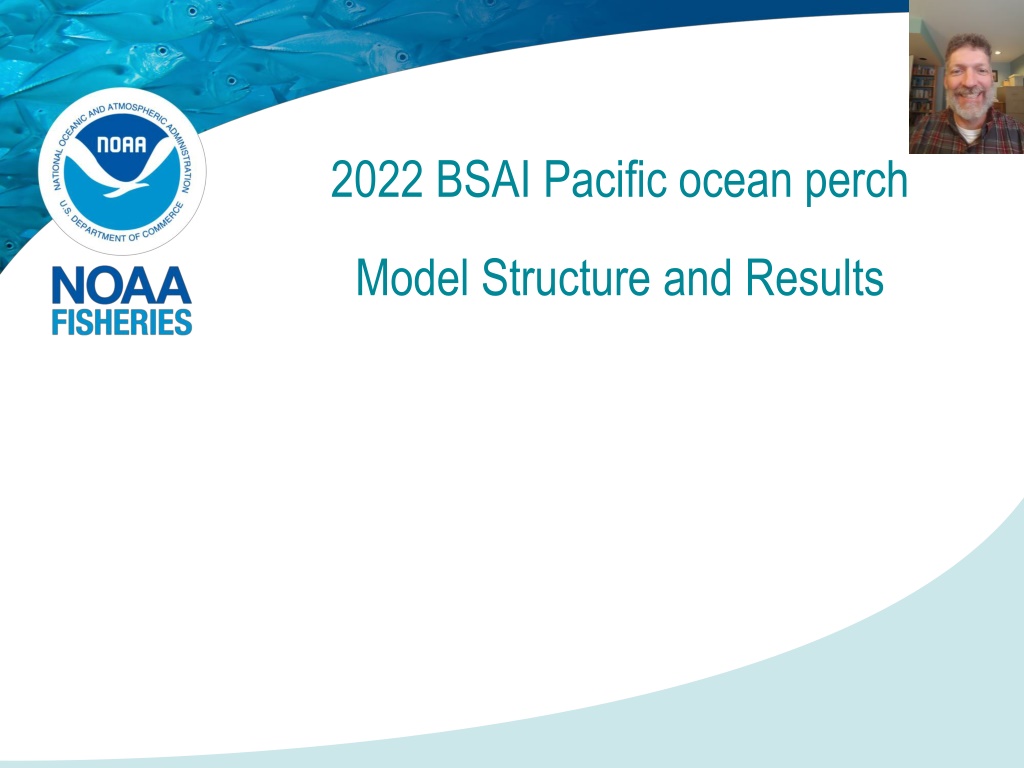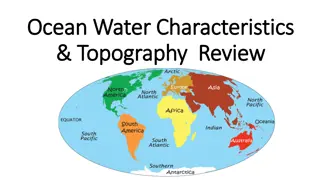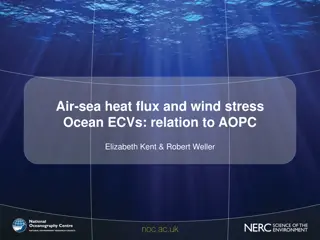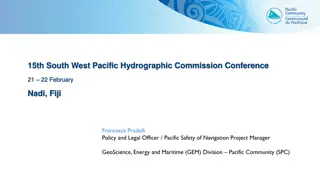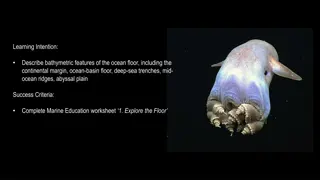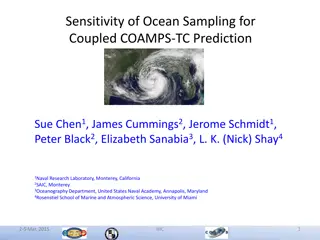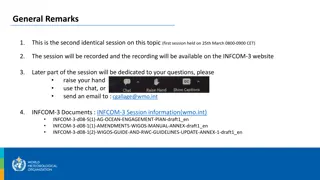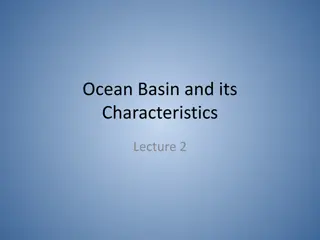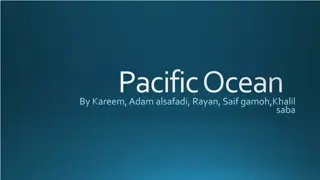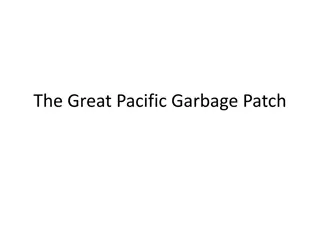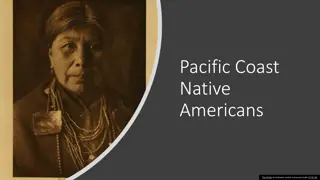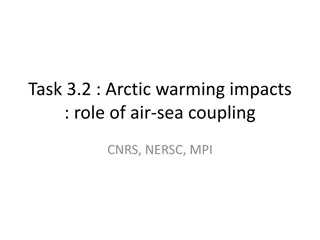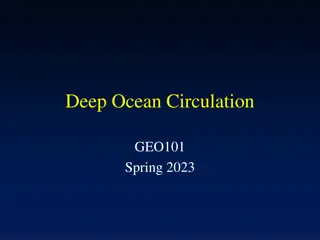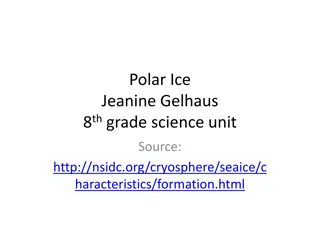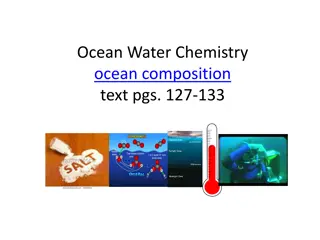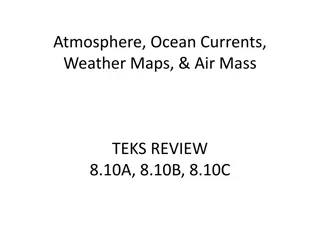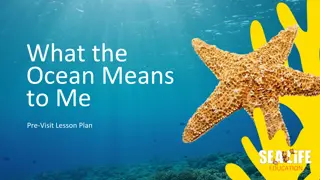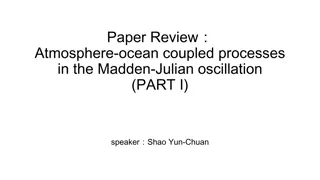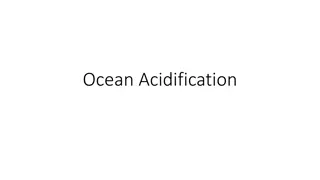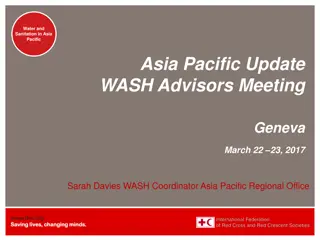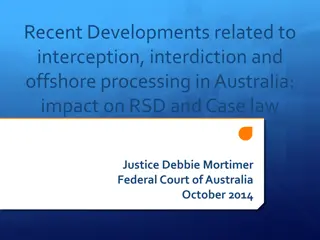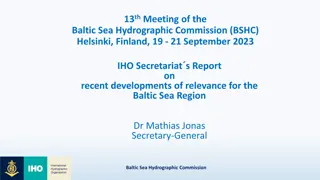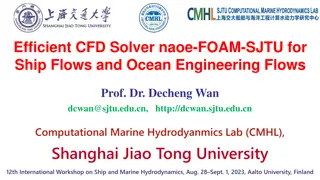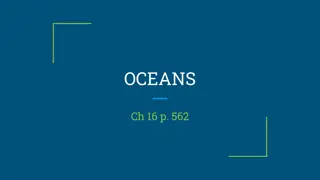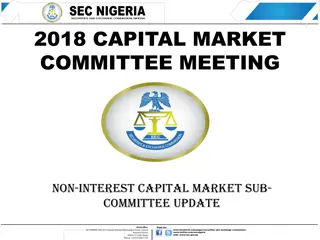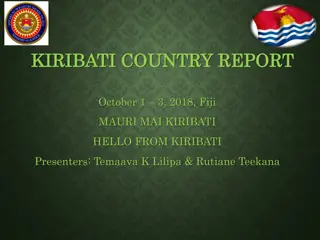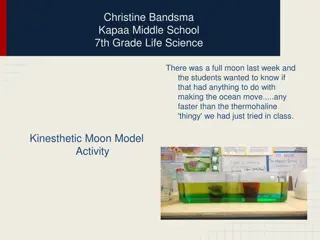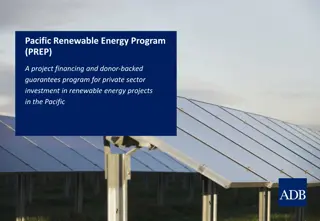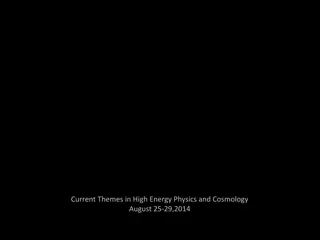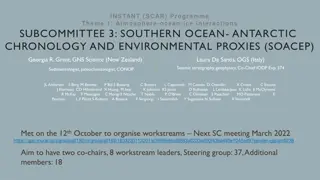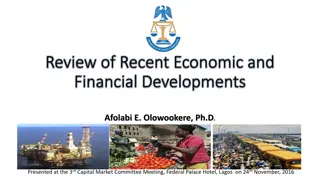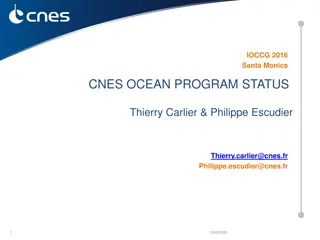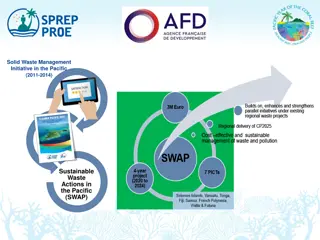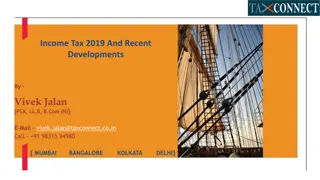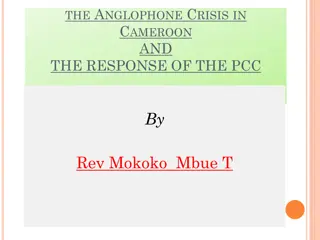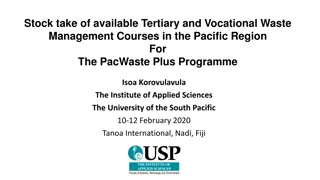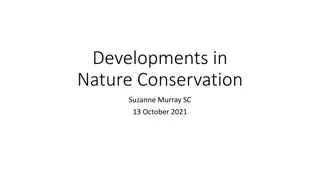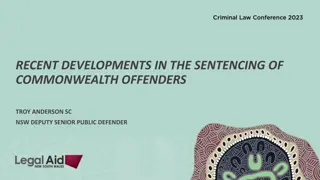Overview of BSAI Pacific Ocean Perch Model Structure and Recent Developments
The BSAI Pacific Ocean Perch assessment model has evolved over the years, with a history dating back to pre-2000. Recent developments include the combination of separate models for AI and EBS, adjustments to age error matrices, and enhancements in handling composition data. The model structure focuses on recruitment, annual deviations, and initial abundance parameters. These advancements have improved the accuracy and robustness of the assessment model for Pacific Ocean Perch in the BSAI region.
Download Presentation

Please find below an Image/Link to download the presentation.
The content on the website is provided AS IS for your information and personal use only. It may not be sold, licensed, or shared on other websites without obtaining consent from the author. Download presentation by click this link. If you encounter any issues during the download, it is possible that the publisher has removed the file from their server.
E N D
Presentation Transcript
2022 BSAI Pacific ocean perch Model Structure and Results
BSAI POP Outline 1) History of assessment 2) Recent model changes 3) Model structure 4) Model likelihoods 5) Parameter estimates 6) Data fits 7) Retrospective results, and uncertainty U.S. Department of Commerce | National Oceanic and Atmospheric Administration | NOAA Fisheries | Page 1
History of assessment models Prior to 2000: stock synthesis Current model based on forward projecting population model, with separable fishing mortalities Coded in ADMB, similar to many other AFSC models: 1) AMAK; 2) Courtney et al. 2007; 3) GOA POP model U.S. Department of Commerce | National Oceanic and Atmospheric Administration | NOAA Fisheries | Page 2
Recent model developments 2001: Combined BSAI model (previously separate models for AI and EBS) 2006: Prior distributions are used for natural mortality and AI survey catchability 2012: Increased plus group from 25 to 40 years 2012: Maturity curve estimated within the model 2012: Aging error matrix adjusted to account for ageing errors within plus group 2014: Bicubic spline for fishery selectivity 2014: Extended ageing error matrix U.S. Department of Commerce | National Oceanic and Atmospheric Administration | NOAA Fisheries | Page 3
Recent model developments (continued) 2016: McAllister-Ianelli iterative reweighting of age/length composition data 2016: EBS slope survey biomass and composition data used in assessment U.S. Department of Commerce | National Oceanic and Atmospheric Administration | NOAA Fisheries | Page 4
Model Structure U.S. Department of Commerce | National Oceanic and Atmospheric Administration | NOAA Fisheries | Page 5
Model Structure: Numbers at age Recruitment (age 3) ? ?2,?= ???+?? Parameters: Mean recruitment: log-scale, freely estimated Annual recruitment deviations: log-scale, constrained by recruitment variability ( r) Initial abundance ??,1960= ?????? ? 3 ? ??+,1960= ?????? ?+ 3 ?/ 1 ? ? Parameters Initial recruitment for unfished population, equilibrium population assumption U.S. Department of Commerce | National Oceanic and Atmospheric Administration | NOAA Fisheries | Page 6
Model Structure: Numbers at age Annual numbers at age ??,?= ?? 1,? 1? ?+?? 1,? 1= ?? 1,? 1? ?? 1,? 1 Parameters: Natural mortality: log-scale, constrained with prior penalty Fishing mortality Plus group numbers ??+,?= ??+ 1,? 1? ??+ 1,? 1+ ??+,? 1? ??+,? 1 Spawning biomass ?+ ?? ????,?? ??,? ??_???? ???= ?=3 U.S. Department of Commerce | National Oceanic and Atmospheric Administration | NOAA Fisheries | Page 7
Model Structure: Catch Annual Catch ??= ?+ ??,???,?1 ? ??,? ??,? ?? Parameters: Fishing mortality ?=3 Annual Fishing Mortality ? ???= ??,? ????+?? ??,?= ??,? Parameters Fishing selectivity Mean fishing mortality: log-scale, freely estimated Fishing mortality deviations: log-scale, constrained with penalty U.S. Department of Commerce | National Oceanic and Atmospheric Administration | NOAA Fisheries | Page 8
Model structure: Fishery selectivity ADMB function bicubic_spline bicubic_spline(scal_yr_nodes, scal_age_nodes, sel_par, log_sel_fish); 2010 Based in code from Numerical Recipes (Press et al 1992) 2000 location where selectivity is interpolated 1990 knot locations Year 1980 1970 1960 0 10 20 30 40 Age Methods for controlling smoothness 1) Number of knots (I use 5 for age and 5 for year) 2) First derivative across ages (descending only; controls dome-shapeness) 3) Second derivative across ages (controls smoothness) 4) First and second derivatives across years U.S. Department of Commerce | National Oceanic and Atmospheric Administration | NOAA Fisheries | Page 9
Model structure: Survey index Aleutian Islands bottom trawl survey ?+ ??= ????? ??? ??,??? ?=3 Eastern Bering Sea slope bottom trawl survey ?+ ??= ??????? ??? ??,??? ?=3 Parameters Survey selectivity (q): estimated on log-scale, with prior Survey selectivity (logistic) Proportion of biomass in survey area ( ) U.S. Department of Commerce | National Oceanic and Atmospheric Administration | NOAA Fisheries | Page 10
Model structure: Composition data Bottom trawl survey age ? ??,??? ?=3 ? ??,? = ?? ? ?+??,??? ? Fishery age ??,? ?+ ? ??,? = ?? ? ?? ?=3 Fishery length ??,? ?+ ?= ?? ? ??,? ??,? ?=3 U.S. Department of Commerce | National Oceanic and Atmospheric Administration | NOAA Fisheries | Page 11
Model structure: Parameters Estimated within the model: Parameter type 1) Fishing mortality mean 2) Fishing mortality deviations 3) Recruitment mean 4) Recruitment deviations 5) Unfished recruitment 6) Biomass survey catchabilities 7) Fishery selectivity parameters 8) Survey selectivity parameters 9) Natural mortality rate 10) Maturity parameters Total parameters Number 1 61 1 58 1 2 25 4 1 2 156 U.S. Department of Commerce | National Oceanic and Atmospheric Administration | NOAA Fisheries | Page 12
Model structure: parameters Estimated outside the model Parameter type Von Bertalanffy length at age parameters Weight at length parameters SD in length with age (polynomial) Aging error (linear) Proportion of stock in survey subareas Number 3 2 5 2 1 U.S. Department of Commerce | National Oceanic and Atmospheric Administration | NOAA Fisheries | Page 13
Model Likelihoods U.S. Department of Commerce | National Oceanic and Atmospheric Administration | NOAA Fisheries | Page 14
Model Likelihoods: Fitted data Catch: ? ?= 500, ? = 0.0001 2 ??+ ? ??+ ? ? ?= ? ? ln ? Bottom trawl survey biomass: CV = Coefficient of variation for survey biomass estimate 2 ?? ?? 1 ? ?= 2ln 2 ???,? ? U.S. Department of Commerce | National Oceanic and Atmospheric Administration | NOAA Fisheries | Page 15
Model Likelihoods: Fitted data Age and length compositions (fishery and survey): ??,? is a reweighted sample size ? ? ? ? ? ?? ? = ??,? ??,? ln ??,? + ? ? ? Input sample sizes are the square root of the number of observations, and this is reweighted with the McAllister-Ianelli procedure. U.S. Department of Commerce | National Oceanic and Atmospheric Administration | NOAA Fisheries | Page 16
Model Likelihoods: Fitted data Maturity at age: Binomial distribution, with two data sets. ????= ?? ??,??? ? + ??,? ??,? 1 ln(? ? ? D = dataset, n = number of fish observed, y = number of mature fish observed, = estimated proportion maturity by age. The weights ( ) can differ by age to allow sensible fits at low ages U.S. Department of Commerce | National Oceanic and Atmospheric Administration | NOAA Fisheries | Page 17
Model Likelihoods: Priors/penalties Prior parameter penalty 2 1 ? ??= 2ln ?????? 2?? Natural Mortality 0.05 0.05 AI survey catchability 1.0 0.45 Prior Prior CV U.S. Department of Commerce | National Oceanic and Atmospheric Administration | NOAA Fisheries | Page 18
Model Likelihoods: Priors/penalties Recruitment deviations ?+ ?ln?? ??= ?? ? Fishing mortality deviations: ??= 0.1 ? ??= ?? ?? ? U.S. Department of Commerce | National Oceanic and Atmospheric Administration | NOAA Fisheries | Page 19
Data weighting General approach is that the second stage sample sizes ( ) are the product of a first stage sample sizes ( ) and a weight y j N, N, ~ j y ~ = N w N , , j y j j y A single weight for each data type (j) The weights are updated with each model run, and iterated until they converge U.S. Department of Commerce | National Oceanic and Atmospheric Administration | NOAA Fisheries | Page 20
Data weighting McAllister-Ianelli (method TA1.1 in Francis 2011) Weight by the average ratio of effective sample size to the stage 1 sample size U.S. Department of Commerce | National Oceanic and Atmospheric Administration | NOAA Fisheries | Page 21
Model Results U.S. Department of Commerce | National Oceanic and Atmospheric Administration | NOAA Fisheries | Page 22
Results Recuitment Fishing mortality Fishing selectivity Bottom trawl selectivity, catchability Comparison of previous values Natural mortality Parameter CVs CVs on total and spawning biomass U.S. Department of Commerce | National Oceanic and Atmospheric Administration | NOAA Fisheries | Page 23
Model Results: Recruitment U.S. Department of Commerce | National Oceanic and Atmospheric Administration | NOAA Fisheries | Page 24
Model Results: Recruitment Estimated mean log recruitment = 4.32 U.S. Department of Commerce | National Oceanic and Atmospheric Administration | NOAA Fisheries | Page 25
Model Results: Fishing mortality U.S. Department of Commerce | National Oceanic and Atmospheric Administration | NOAA Fisheries | Page 26
Model Results: Fishery selectivity U.S. Department of Commerce | National Oceanic and Atmospheric Administration | NOAA Fisheries | Page 27
Model Results: Bottom trawl survey selectivity Eastern Bering Sea (red), Aleutian Islands (black) U.S. Department of Commerce | National Oceanic and Atmospheric Administration | NOAA Fisheries | Page 28
Model Results: Bottom trawl survey catchability AI catchability has been ~ 1.3 U.S. Department of Commerce | National Oceanic and Atmospheric Administration | NOAA Fisheries | Page 29
Model Results: Bottom trawl survey catchability Other studies U.S. Department of Commerce | National Oceanic and Atmospheric Administration | NOAA Fisheries | Page 30
Model results: natural mortality 2020 assessment estimate: 0.056 0.07 0.06 Survey Cathability 0.05 0.04 0.03 0.02 0.01 0 2008 2010 2012 Assessment Year 2014 2016 2018 2020 U.S. Department of Commerce | National Oceanic and Atmospheric Administration | NOAA Fisheries | Page 31
Model Results Data fits U.S. Department of Commerce | National Oceanic and Atmospheric Administration | NOAA Fisheries | Page 32
BSAI fishery age composition U.S. Department of Commerce | National Oceanic and Atmospheric Administration | NOAA Fisheries | Page 33
Pearson residuals fishery age comps Blue is positive, red is negative U.S. Department of Commerce | National Oceanic and Atmospheric Administration | NOAA Fisheries | Page 34
Fishery length composition U.S. Department of Commerce | National Oceanic and Atmospheric Administration | NOAA Fisheries | Page 35
Pearson residuals fishery length comps Blue is positive, red is negative U.S. Department of Commerce | National Oceanic and Atmospheric Administration | NOAA Fisheries | Page 36
AI survey age composition U.S. Department of Commerce | National Oceanic and Atmospheric Administration | NOAA Fisheries | Page 37
Pearson residuals AI survey age comps Blue is positive, red is negative U.S. Department of Commerce | National Oceanic and Atmospheric Administration | NOAA Fisheries | Page 38
EBS survey age composition Not a great fit to the EBS survey age compositions 2000 year class is strong in the AI age data, not so much in the EBS data U.S. Department of Commerce | National Oceanic and Atmospheric Administration | NOAA Fisheries | Page 39
Pearson residuals EBS survey age comps Blue is positive, red is negative U.S. Department of Commerce | National Oceanic and Atmospheric Administration | NOAA Fisheries | Page 40
Fit to the AI survey U.S. Department of Commerce | National Oceanic and Atmospheric Administration | NOAA Fisheries | Page 41
Fit to the EBS survey index U.S. Department of Commerce | National Oceanic and Atmospheric Administration | NOAA Fisheries | Page 42
Model Results Derived variables, and management reference points U.S. Department of Commerce | National Oceanic and Atmospheric Administration | NOAA Fisheries | Page 43
Total and Spawning biomass U.S. Department of Commerce | National Oceanic and Atmospheric Administration | NOAA Fisheries | Page 44
Phase plane plot U.S. Department of Commerce | National Oceanic and Atmospheric Administration | NOAA Fisheries | Page 45
Projected SSB U.S. Department of Commerce | National Oceanic and Atmospheric Administration | NOAA Fisheries | Page 46
Model Results Diagnostics (Retrospective analysis, likelihood profiles) Uncertainty Parameter correlations U.S. Department of Commerce | National Oceanic and Atmospheric Administration | NOAA Fisheries | Page 47
BSAI POP retrospective pattern Mohn s rho = -0.24 (-0.45 in 2018 assessment) U.S. Department of Commerce | National Oceanic and Atmospheric Administration | NOAA Fisheries | Page 48
Retrospective estimates of recruitment U.S. Department of Commerce | National Oceanic and Atmospheric Administration | NOAA Fisheries | Page 49
